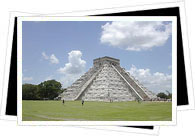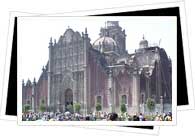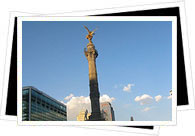Mexico has a long and illustrious history. Ancient cultures and civilizations, colonial times and modern events have contributed to make Mexico the country it is today.

The earliest inhabitants of Mexico were Stone Age hunter-gatherers who settled into the land at around 10,000 B.C. After this, there were quite a number of cultures that occupied different regions. Early civilizations include the Toetihuacans, the Mayans, the Olmecs, the Zapotecs, Toltecs, Aztecs, Mixtecs and other minor groups.
The Teotihuacans settled into the Valley of Mexico at around 200 A.D. Teotihuacan is also the name of the ancient city where great temples and monuments were built, such as the Pyramid of the Sun, the Pyramid of the Moon and the Avenue of the Dead.
Meanwhile, the Olmecs settled into the land 1150 to 300 BC. It was the Olmecs who developed a calendar (with a 52-year cycle) that influenced other cultures such as the Mayans and the Aztecs. They were also credited for setting up the basic principles of architecture and the layout of the city.
The Aztecs were also called the “Mexicas,” from which we get the word “Mexico.” They occupied the valley of Mexico sometime in the 13th century. Their capital, the city of Tenochtitlan is now today's Mexico City. Also, at around 250 A.D., the Mayans began building the stepped pyramids we see in the Yucatan Peninsula.
It was during these civilizations that art and cultural creations developed and flourished. These are what people widely visit and admire until today.

Spain sent several expeditions across the Atlantic to Mexico. The expedition led by Hernan Cortez reached Cozumel in 1519. At that time, Moctezuma II ruled the Aztec empire, which was at the height of its power and wealth. Cortez, seeing the opportunities to be had, stayed in Mexico and eventually took Moctezuma hostage in a bid to wrest his power. Cortez then gained control of the Aztec capital.
Because of his success, Cortez, who was first considered a pirate and a renegade by Spain, was legitimized and named the leader of the conquistadors in the name of Spain. Thus began the campaign to convert the colony (the “New Spain”) to Christianity. The riches Cortez gained catapulted Spain into being the richest country in Europe.
During this time of conquest, because of the wars, the harsh treatment of the colonists and the diseases that plagued the colony, the native population dwindled from around 25 million to only one million by 1605.
It was during the colonial times (the 16th to 19th centuries) that a new class system emerged, with Spaniards born in Spain at the top of the ladder. Then came the criollos (Spaniards born in Mexico), the mestizos (those with mixed Spanish and indigenous blood) and then at the bottom were the indigenous people and the African slaves. The upper class built grand mansions and haciendas which are part of Mexico's architectural treasures even until now.

Spain continued to increases the taxes and contributions required from the colony. This and Napoleon's occupation of Spain (in 1808) sparked the movement towards independence. A criollo priest by the name of Miguel Hidalgo issued the Grito de Dolores (a call for independence), which started the revolution. Hidalgo, who is called the “Father of Mexican Independence” was executed and his movement was succeeded by Jose Maria Morelos. Spain eventually agreed to Mexican independence in 1821.

Mexico, having become a republic, then suffered a politically unstable and tumultuous era in its history. For the next 22 years following independence, the presidency shifted from one person to another 36 times!
1845 bore witness to the Mexican-American War, which resulted in Mexico ceding California, Texas, Colorado, Utah and a large part of Arizona and New Mexico to the United States.
More problems arose and social conditions took a turn for the worse. Revolutions followed one after the other, with ambitious leaders scrambling to grasp power of the country. A flurry of exiles, assassinations and coups characterized this era.
It was in 1934 - during Cardenas' time - when reforms were made, including the redistribution of land and nationalization of the oil industry. Sadly, the presidents that succeeded Cardenas were concerned about lining their pockets more than in leading the country to progress.
Mexico was plagued by corruption, earthquakes and military and political upheavals. This resulted in a deep economic recession during the 1990s. But with moves made by President Ernesto Zedillo, the economy was able to get out of its economic slump.
Currently, there is relative peace in the country, but it still has a long way to go towards building a strong nation. Mexico has developed and rapidly urbanized, building strong infrastructures for tourism.